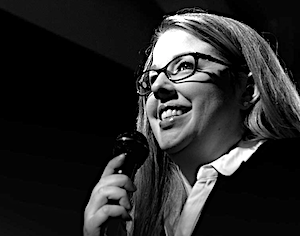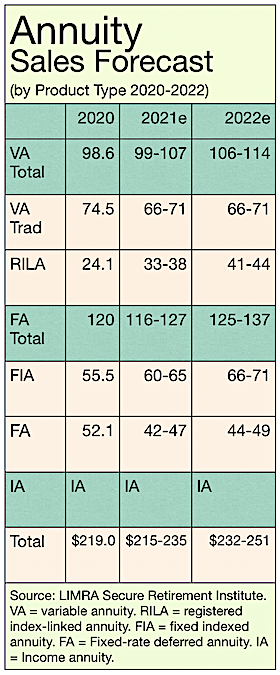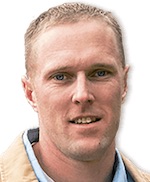
Relatively speaking, an indexed annuity was once as simple as a Schwinn bicycle with fat tires and a three-speed gear shift. The early contracts gave policyholders partial exposure to the growth of just three or four common indices: the S&P 500, the NASDAQ and the Russell 2000 or MSCI-EAFE.
Today’s indexed annuities are more like 21-speed mountain bikes. Some contracts offer a dozen index options, including hybrid indices, factor-driven indices, and (especially) volatility-controlled indices whose algorithms dynamically reallocate assets in response to market signals that only computers can hear.
Over the past six or seven years, the number of indices available to buyers of fixed indexed and registered index-linked annuities (FIAs and RILAs, respectively) has mushroomed to more than 140, according to a list compiled by The Index Standard, a fintech startup that analyzes the indexes in annuities for advisers and clients. (*See list disclaimer at end of this article.)
More choice is presumably better. Access to 21 gears can smooth a mountain biker’s path over rocks and through arroyos. A deferred indexed annuity with lots of indices can theoretically smooth an investor’s path across three to ten years of unpredictable and unforgiving markets.
But choice adds complexity. Annuity issuers have not yet shown advisers how to optimize the use of the new indices, one observer told RIJ. While 40% of the money that flowed into FIAs in 2020 went into hybrid indices, over half still went into the S&P 500 Index, according to Wink Intel.
In this second week of RIJ’s annual four-week focus on FIAs and RILAs, we provide capsule summaries of just five indices in indexed annuities. These are offered as examples, not as recommendations. They reveal a few of the mechanisms that provide diversification and volatility management that indexes use.
The mechanisms range from simple averaging across sub-indexes, or periodic rebalancing according to changes in the performance of certain sectors or factors. Some indexes use short sales to manage volatility. Given the tools available to actuaries and quants, the possibilities are unlimited.
JPMorgan Mosaic II
This momentum-seeking index, created in 2016, offers exposure to equities, bonds, and commodities and aims for 4.2% volatility. From a universe of 15 assets consisting of global equity futures, bond futures and commodities, the managers pick the nine assets with the highest returns over the last six months. They allocate to these assets using risk parity, and then use a dynamic volatility control mechanism on the risk parity portfolio and notional cash to hit the volatility target. It uses leverage of up to 300% on the components.
“Overall this is a well constructed index,” according to The Index Standard. But a period of flat results has made it into a cautionary tale of a volatility-controlled index that isn’t nimble. “When a stressful market begins to recover, such as in the end of 2018 and March 2020, the index can be slow to move back into risky assets and may lag in subsequent bull markets,” The Index Standard analysis said.
Performance Blend-Weighted Average
This index, a throwback to an earlier stage of FIA product development, is noteworthy for being the only hybrid index offered in the top-selling contract from Athene, the top-seller of FIAs in 2020, according to Wink Intel. The return of this index is calculated based on the relative performance of the S&P 500, Russell 2000, and MSCI EAFE indices, according to product literature.
Half of the interest credited to the contract owner for a given crediting period is based on the index with the best performance (i.e., the one with the largest positive or least negative change during the period). Thirty percent of the interest is based on the index with the next best performance. Twenty percent is based on performance of the weakest-performing index.
BlackRock iBLD Claria
This index was one of several available in 2020’s top-selling FIA contract, the Allianz Benefit Control Annuity. In addition to three common indexes (the S&P 500, NASDAQ-100, and MSCI-EAFE), this contract offers access to three dynamically re-allocated indexes of ETFs: BlackRock iBLD Claria Index, Bloomberg US Dynamic Balance Index II, and PIMCO Tactical Balanced Index.
An index of indices, the BlackRock iBLD Claria reallocates daily to an equity component (consisting of iShares ETFs tracking the Russell 2000, S&P 500, MSCI EAFE, and MSCI Emerging Markets) and a bond component (iShares ETFs tracking 1-3 year, 3-7 year, and 7-10 year Treasury Bonds) based on historical realized volatility (i.e., the past annualized standard deviation of returns).
This contract also allows the owner to lock in an index value on any of individual indexed interest allocation(s) one time at any point during the crediting period. The beginning index value for the next crediting period will be the index value at the end of the previous crediting period (not the locked-in value).
Shiller Barclays CAPE US Sector Risk Controlled 10% USD Excess Return Index
This index of indices is a volatility-controlled version of the Shiller Barclays CAPE US Sector TR USD Index (CAPE stands for Cyclically Adjusted Price Earnings ratio). It was created in 2014 by Nobel Prize-winning economist, Yale professor and author Robert Shiller.
This index uses derivatives (options or futures) to get “notional long exposure to the top four US equity sectors that appear to be relatively undervalued, as defined by a modified version of the CAPE Ratio and that possess relatively strong price momentum over the prior twelve months.”
Each month, that index ranks the pre-defined, fixed universe of exchange-traded funds— Select Sectors SPDR Funds specializing in Energy, Materials, Industrial, Consumer Discretionary, Consumer Staples, Health Care, Financial, Utilities, Technology, Real Estate and Communications Services—and removes the six most overvalued sectors (as measured by their Relative CAPE Indicators).
Of the remaining five sectors, the sector with the lowest twelve-month price momentum is removed. The underlying index then allocates equally to the four remaining index components for the relevant month. In addition, the Index targets a 10% volatility level by reducing exposure to any of the sector indexes where volatility is rising.
NYSE Zebra Edge Index
Created by the eminent Roger Ibbotson, past professor at Yale and the University of Chicago, and founder of Ibbotson Associates (now part of Morningstar, Inc.) and Zebra Capital Management, this index looks for “the most popular equities” in terms of trading activity and risk, among the 500 largest US public companies.
Every quarter (February, May, August and November) it filters out the stocks most frequently traded over the preceding two years and with the highest three-month and one-year volatility. That process reveals about 200 less-popular and less-risky equities. These are weighted equally.
At the end of 2020, this process resulted in the following sector allocations (approximately): Industrials (22%), Financials (19%), Consumer Goods (13%), Utilities (11%), Technology (10%), Health Care (10%), Consumer Services (9%), Basic Materials (4%), Telecommunication (2%), and Oil & Gas, (0%).
Managing expectations
Anyone comparing indices inside an annuity needs to keep in mind that, while the index might offer the sector or the factor exposure that he or she takes an interest in, the annuity owner doesn’t necessarily receive all of the index gain or incur all of the index loss over a contract year or crediting term.
The contract owner’s gain (or loss, in the case of a RILA) depends entirely on a set of options on the index. When someone buys a FIA, for example, the issuer might apply about 2% of the purchase premium to the purchase of options on the selected indices. This “options budget” might be increased by using the dividend yield from the stocks in the index. A RILA’s option budget will typically be larger than an FIA’s, because the a RILA only insures about 10% of a contract owner’s money against potential loss, while an FIA insures 100%.
“The buffered payoff in a RILA is a cheaper hedge compared to an option’s hedge with a FIA,” said Tom Haines, senior vice president, Capital Markets and Index Solutions at Annexus, in an interview. “The hedge budgets on buffered annuities have been and could be lower but this can change if the carrier wants to be competitive.”
Sometimes the contract offers a crediting method with no cap on the gains. In that case, all of the index gain might accrue to the owner, even though he or she isn’t invested directly in the index. In such cases, the index will usually contain volatility controls that, in addition to limiting the potential for loss, also limit the potential for gain. There’s an inherent trade-off.
For more on the hybrid indexes in FIAs and RILAs, see the accompanying article in today’s issue of RIJ.
*Past performance is not indicative of future performance. The Index Standard® is not a registered investment advisor, and nothing in The Index Standard®‘s reports is intended, and it should not be construed, to be investment advice. This material has been prepared by The Index Standard® on the basis of publicly available information internally developed and other third-party resources believed to be reliable. The Index Standard® did not attempt to verify the information independently. No representation is made as to the accuracy of the assumptions made within, or completeness of any opinion, report, rating, or scenarios. No representation is made that any omissions or error in any of its opinion, report, rating, or scenarios will be corrected. The Index Standard is not obliged to inform the recipients of this website, or communication of any change to any opinion, report, rating, or scenarios. All opinions, reports, ratings, and scenarios of The Index Standard® are subject to change.
© 2021 RIJ Publishing LLC. All rights reserved.












